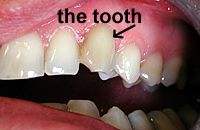
All dentists spend a considerable time in their university training learning about the inside of your teeth.
The inside of a tooth has a complicated hollow system which in normal health is the home of the pulp (nerves and blood vessels). These hollow areas are called root canal/s.
When we are concentrating on the inside of a teeth we talk about Endodontic treatment or Root Canal treatment. ('Endo' means inside and 'odont' is a tooth.)
What happens when the pulp or nerve inside the tooth 'dies' or you get an abscess?
When the pulp in the tooth is destroyed or "dies" the inside (pulp chamber or root canal) becomes empty or full of "dead" (necrotic) body fluids. Bacteria finds this space and starts to grow.
The body's defense mechanisms can not remove the bacteria so an infection forms.
Common causes of pulp damage:
Why do I have pain if my tooth is "dead"
The cause of pain once a tooth 'dies' is the pressure, of the 'dead' contents of the inside of the tooth (consisting of dead pulp tissue, debris, and bacteria), on the surrounding bone and gums (periodontal ligament ) so the tooth often feels painful to touch yet may not be sensitive to changes in temperature. Symptoms most commonly associated with a 'dead' nerve are a tooth that hurts to bite on, becomes sore to touch or push on, and in acute stages facial swelling occurs.
Non-painful death!
Some people have pulp damage without any knowledge that there could be a problem. A dentist may discover a 'dead' tooth with radiographs or other signs in the gums around a dead tooth.
Why would we need to treat a dead tooth. Cant I just take antibiotics?
Antibiotics wont get rid of all the infection in a teeth. We now know how important it is to remove all infections as dental infections have been linked to heart attacks and strokes.
What's involved in root canal (endodontic) treatment?
Endodontic treatment of a tooth involves:
 It may be necessary to remove any restorations (fillings or crowns) in teeth before the root canal treatment. This to attempt to seal out bacteria. Usually a temporary restoration (filling or crown) is placed in the tooth until the root canal treatment is completed. Then a final restoration will be placed in the tooth.
It may be necessary to remove any restorations (fillings or crowns) in teeth before the root canal treatment. This to attempt to seal out bacteria. Usually a temporary restoration (filling or crown) is placed in the tooth until the root canal treatment is completed. Then a final restoration will be placed in the tooth. Tiny metal files are used to carefully clean the 'gunk' (pulp, bacteria, pus etc.) out of the root canals. These tiny metal files are used to shape the root canals to accept the filling material.
Tiny metal files are used to carefully clean the 'gunk' (pulp, bacteria, pus etc.) out of the root canals. These tiny metal files are used to shape the root canals to accept the filling material.Once the root canal treatment is completed we may require monitoring the healing process with additional xrays.
Crowns: We may recommend you have the root canal treated tooth crowned to improve the strength and decrease the risk of the tooth fracturing.
Possible complications of root canal treatment
Please speak to us about any concerns you have with root canal treatment.
All dental and medical treatment has risks and as an unique part of your unique makeup each tooth is different so not every complication can be listed.
We can give you an estimate of the costs of the root canal treatment. We can also give you costs for placement of a crown or restoration after treatment.
As the final treatment may vary from the original estimate the final costs may be different.
Hours:
Mon-Fri 9am-5:30pm
Sat 8:30am-1pm
63 Police Rd
Mulgrave
VIC 3170 AU
Dr Daphne Ong BDSc (Melb)
Dr Cedric Ong BHSc/MDent